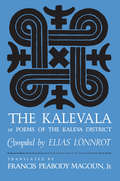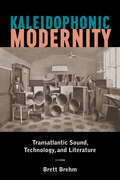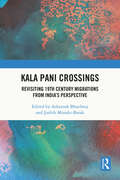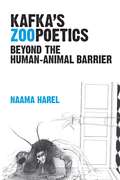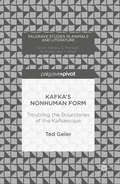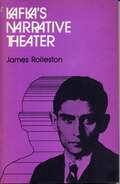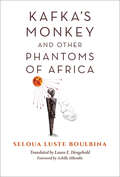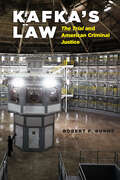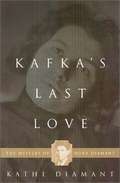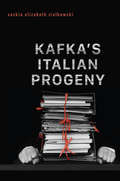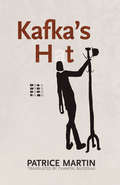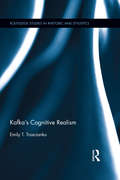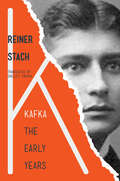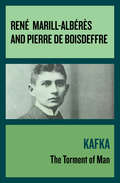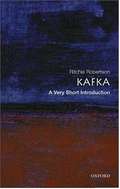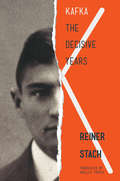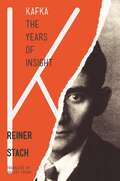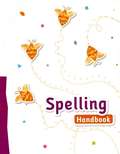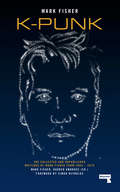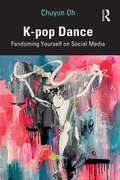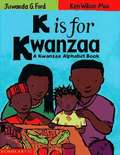- Table View
- List View
The Kalevala: Or, Poems of the Kaleva District
by Elias LönnrotThe national folk epic of Finland is here presented in an English translation that is both scholarly and eminently readable. To avoid the imprecision and metrical monotony of earlier verse translations, Francis Magoun has used prose, printed line for line as in the original so that repetitions, parallelisms, and variations are readily apparent. The lyrical passages and poetic images, the wry humor, the tall-tale extravagance, and the homely realism of the Kalevala come through with extraordinary effectiveness.
Kaleidophonic Modernity: Transatlantic Sound, Technology, and Literature
by Brett BrehmWhat stories remain hidden behind one of the most significant inventions of the nineteenth century? Kaleidophonic Modernity reexamines the development of mechanical sound recording technology by charting the orbits of writers, scientists, and artists in France and the United States. Working between comparative literature, the history of science, and urban studies, Brehm builds a bridge between visual culture and sound studies.Kaleidophonic Modernity places the poet and inventor Charles Cros and his lover, the celebrated concert pianist and salonnière Nina de Villard at the heart of modern aesthetic and scientific vanguards. Cros's scientific endeavors ranged from color photography, to telecommunications, to mechanical sound reproducibility. In his poetry the Surrealists found an ancestor and inspiration. His literary and scientific works prove startling and relevant to predicaments of technological media in his own time and ours. For nearly twenty years Nina de Villard presided over a supremely daring intellectual salon. There, she welcomed manifold literary, artistic, and musical luminaries into a veritable crucible of the artistic avant-garde and precursor to the famous Chat Noir cabaret. Together, these two forgotten but pivotal figures, Cros and Villard, help reframe our thinking on Edgar Allan Poe, Charles Baudelaire, and Walt Whitman, icons of urban modernity who can now be seen and heard in a kaleidophonic light, one that offers a compelling new perspective on modern mediascapes.In elaborating this transatlantic phenomenon, Kaleidophonic Modernity illuminates the prehistory of the phonograph as it intersects with the aesthetics of sound reproducibility, Franco-American literary exchange, Poe’s aesthetic and intellectual legacy, the sounds of modern cities and technologies, and the genealogy of audiovisual experimentation found in such movements as Dada, Futurism, and the sound art of today.
Kala Pani Crossings: Revisiting 19th Century Migrations from India’s Perspective
by Judith Misrahi-Barak Ashutosh BhardwajWhen used in India, the term Kala pani refers to the cellular jail in Port Blair, where the British colonisers sent a select category of freedom fighters. In the diaspora it refers to the transoceanic migration of indentured labour from India to plantation colonies across the globe from the mid-19th century onwards. This volume discusses the legacies of indenture in the Caribbean, Reunion, Mauritius, and Fiji, and how they still imbue our present. More importantly, it draws attention to India and raises new questions: doesn’t one need, at some stage, to wonder why this forgotten chapter of Indian history needs to be retrieved? How is it that this history is better known outside India than in India itself? What are the advantages of shining a torch onto a history that was made invisible? Why have the tribulations of the old diaspora been swept under the carpet at a time when the successes of the new diaspora have been foregrounded? What do we stand to gain from resurrecting these histories in the early 21st century and from shifting our perspectives? A key volume on Indian diaspora, modern history, indentured labour, and the legacy of indentureship, this co-edited collection of essays examines these questions largely through the frame of important works of literature and cinema, folk songs, and oral tales, making it an artistic enquiry of the past and of the present. It will be of great interest to scholars and researchers of world history, especially labour history, literature, postcolonial studies, cultural studies, diaspora studies, sociology and social anthropology, Indian Ocean studies, and South Asian studies.
Kafka's Zoopoetics: Beyond the Human-Animal Barrier
by Naama HarelNonhuman figures are ubiquitous in the work of Franz Kafka, from his early stories down to his very last one. Despite their prominence throughout his oeuvre, Kafka’s animal representations have been considered first and foremost as mere allegories of intrahuman matters. In recent years, the allegorization of Kafka’s animals has been poetically dismissed by Kafka’s commentators and politically rejected by posthumanist scholars. Such critique, however, has yet to inspire either an overarching or an interdiscursive account. This book aims to fill this lacuna. Positing animal stories as a distinct and significant corpus within Kafka’s entire poetics, and closely examining them in dialogue with both literary and posthumanist analysis, Kafka’s Zoopoetics critically revisits animality, interspecies relations, and the very human-animal contradistinction in the writings of Franz Kafka. Kafka’s animals typically stand at the threshold between humanity and animality, fusing together human and nonhuman features. Among his liminal creatures we find a human transformed into vermin (in “The Metamorphosis”), an ape turned into a human being (in “A Report to an Academy”), talking jackals (in “Jackals and Arabs”), a philosophical dog (in “Researches of a Dog”), a contemplative mole-like creature (in “The Burrow”), and indiscernible beings (in “Josefine, the Singer or the Mouse People”). Depicting species boundaries as mutable and obscure, Kafka creates a fluid human-animal space, which can be described as “humanimal.” The constitution of a humanimal space radically undermines the stark barrier between human and other animals, dictated by the anthropocentric paradigm. Through denying animalistic elements in humans, and disavowing the agency of nonhuman animals, excluding them from social life, and neutralizing compassion for them, this barrier has been designed to regularize both humanity and animality. The contextualization of Kafka's animals within posthumanist theory engenders a post-anthropocentric arena, which is simultaneously both imagined and very real.
Kafka's Nonhuman Form
by Ted GeierThis book is a compact study of Kafka's inimitable literary style, animals, and ecological thought--his nonhuman form--that proceeds through original close readings of Kafka's oeuvre. With select engagements of Adorno, Derrida, and the literary heritage from Romanticism to Dickens that influenced Kafka, Ted Geier discusses Kafka's literary, "nonhuman" form and the way it unsettles the notion of a natural and simple existence that society and culture impose, including the boundaries between human and animal. Through careful attention to the formal predicaments of Kafka's works and engaging with Kafka's original legal and social thought in his novels and short stories, this book renders Kafka's sometimes impossibly enigmatic work legible at the level of its expression, bringing surprising shape to his work and redefining what scholars and readers have understood as the "Kafkaesque".
Kafka's Narrative Theater
by James RollestonCan one speak of Kafka's heroes as "characters"? If so, why is it so hard to define their characteristics? If not, how is the reader persuaded to accompany them on their existential journeys, accepting their behavior as falling within the realm of human logic? This study argues that Kafka's fiction has two conflicting premises: the subjective impossibility of human existence, foreclosing all hope of "meaning" in individual actions; and the ordered structure of human thoughts which assign meaning to the smallest event and analyze endlessly the behavior of other people. Kafka's characters are always, either potentially or actually, moving in both directions at once, earnestly building up a continuous logic to their actions while skeptically dismantling their own pretensions to existence. The device of the circumscribed narrator, congruent with the hero, knowing only what the hero knows, yet not identical with him, enables Kafka to contain both fundamental tendencies in a single sentence.Although Kafka is widely read, his works seem to give rise very easily to misconceptions; this study is designed primarily to facilitate an intelligent reading of Kafka. Without imposing answers of its own, it seeks to foster an awareness of the problems of perspective and presentation which Kafka engages.
Kafka's Narrative Theater
by James RollestonCan one speak of Kafka's heroes as "characters"? If so, why is it so hard to define their characteristics? If not, how is the reader persuaded to accompany them on their existential journeys, accepting their behavior as falling within the realm of human logic? This study argues that Kafka's fiction has two conflicting premises: the subjective impossibility of human existence, foreclosing all hope of "meaning" in individual actions; and the ordered structure of human thoughts which assign meaning to the smallest event and analyze endlessly the behavior of other people. Kafka's characters are always, either potentially or actually, moving in both directions at once, earnestly building up a continuous logic to their actions while skeptically dismantling their own pretensions to existence. The device of the circumscribed narrator, congruent with the hero, knowing only what the hero knows, yet not identical with him, enables Kafka to contain both fundamental tendencies in a single sentence.Although Kafka is widely read, his works seem to give rise very easily to misconceptions; this study is designed primarily to facilitate an intelligent reading of Kafka. Without imposing answers of its own, it seeks to foster an awareness of the problems of perspective and presentation which Kafka engages.
Kafka's Monkey and Other Phantoms of Africa (World Philosophies)
by Seloua Luste BoulbinaEven though many of France's former colonies became independent over fifty years ago, the concept of "colony" and who was affected by colonialism remain problematic in French culture today. Seloua Luste Boulbina, an Algerian-French philosopher and political theorist, shows how the colony's structures persist in the subjectivity, sexuality, and bodily experience of human beings who were once brought together through force. This text, which combines two works by Luste Boulbina, shows how France and its former colonies are haunted by power relations that are supposedly old history, but whose effects on knowledge, imagination, emotional habits, and public controversies have persisted vividly into the present. Luste Boulbina draws on the work of Michel Foucault, Frantz Fanon, and Édouard Glissant to build a challenging, original, and intercultural philosophy that responds to blind spots of inherited political and social culture. Kafka's Monkey and Other Phantoms of Africa offers unique insights into how issues of migration, religious and ethnic identity, and postcolonial history affect contemporary France and beyond.
Kafka's Law: The Trial and American Criminal Justice
by Robert P. BurnsThe Trial is actually closer to reality than fantasy as far as the client’s perception of the system. It’s supposed to be a fantastic allegory, but it’s reality. It’s very important that lawyers read it and understand this. ” Justice Anthony Kennedy famously offered this assessment of the Kafkaesque character of the American criminal justice system in 1993. While Kafka’s vision of the "Law” in The Trial appears at first glance to be the antithesis of modern American legal practice, might the characteristics of this strange and arbitrary system allow us to identify features of our own system that show signs of becoming similarly nightmarish? With Kafka’s Law, Robert P. Burns shows how The Trial provides an uncanny lens through which to consider flaws in the American criminal justice system today. Burns begins with the story, at once funny and grim, of Josef K. , caught in the Law’s grip and then crushed by it. Laying out the features of the Law that eventually destroy K. , Burns argues that the American criminal justice system has taken on many of these same features. In the overwhelming majority of contemporary cases, police interrogation is followed by a plea bargain, in which the court’s only function is to set a largely predetermined sentence for an individual already presumed guilty. Like Kafka’s nightmarish vision, much of American criminal law and procedure has become unknowable, ubiquitous, and bureaucratic. It, too, has come to rely on deception in dealing with suspects and jurors, to limit the role of defense, and to increasingly dispense justice without the protection of formal procedures. But, while Kennedy may be correct in his grim assessment, a remedy is available in the tradition of trial by jury, and Burns concludes by convincingly arguing for its return to a more central place in American criminal justice.
Kafka's Last Love: The Mystery of Dora Diamant
by Kathi DiamondPublisher's Weekly: Franz Kafka's story is well known, Dora Diamant's is not. She was, as the title states, his last love, and the author (no relation), director of the Kafka Project at San Diego State University, has assiduously tracked the traces of her subjects through personal recollections, private papers and newly opened archives in the former Soviet bloc. Dora (1898- 1952) and Kafka first met at a Baltic resort, and she was instantly captivated by his intelligence and deep sensitivity. Kafka in turn was swept away by the vivacious 25-year-old Polish-born Jew, who had fled her Orthodox family for the broader intellectual currents of Weimar Germany. But Yiddish was her first language and she knew Jewish traditions, and Kafka found her a beacon for the religion his own family had rejected. The author describes at great length the one year the lovers lived together in Berlin, but more interesting is the account of Dora and her larger family history after Kafka's painful death in 1924. Here was a woman intent on keeping Kafka's flame alive, who was forced by war and political upheaval to flee from one country after another. Many relatives died in the Holocaust. Her treasured possessions, Kafka's last diaries, were seized by the Gestapo and have never been found. For 15 years her husband, having served time in Nazi prisons and the Soviet gulag, lived in East Berlin, unaware that Dora and their daughter had survived the war. The remarkable story continues in Moscow, London, San Francisco and Tel Aviv, the far-flung points of dispersal of a family caught in the maelstroms of fascism, communism and the Holocaust.
Kafka’s Italian Progeny (Toronto Italian Studies)
by Saskia Elizabeth ZiolkowskiWhile many scholars of world literature view national literary traditions as resolved and stable, Kafka’s Italian Progeny takes the fluid identity of the modern Italian tradition as an opportunity to reconsider its dimensions and influencers. Exploring a distinct but unexamined Kafkan tradition in modern Italian literature, it brings Italian literary works into larger debates and reorients the critical view of the Italian literary landscape. The book calls attention to the way Kafkan themes, narrative strategies, and formal experimentation appear in a range of Italian authors. Offering new perspectives on familiar figures, such as Italo Calvino, Italo Svevo, and Elena Ferrante, it also sheds light on some lesser-known authors, including Tommaso Landolfi, Paola Capriolo, and Lalla Romano. Using diverse approaches to explore thematic, generic, historical, and cultural connections between Kafka’s works and those of Italian authors, the author argues for a new view of Italian literature that includes talking animals, parental bonds, modernist realism, literary detective novels, and lyrical microfiction. Whereas Kafka has been mobilized in discourses on minor and world literature, Kafka’s Italian Progeny investigates the particular nature of the Italian reception of Kafka to reveal the richness and variety of modern Italian literature.
Kafka's Hat
by Chantal Bilodeau Patrice MartinMultiple plot lines interweave with twentieth-century literary allusions as hapless bureaucrat P. attempts to secure delivery of a valuable cultural relic. Patrice Martin's ticklish tip of the hat to the writing of Franz Kafka also evokes the literary techniques of Jorge Luis Borges, Italo Calvino, and Paul Auster.Polymath Patrice Martin is a writer, musician, and politician who is a former clerk in Canada's House of Commons, and currently is a Gatineau city councilor. He confesses his working life in government bureaucracy helped shape this, his first novel.Chantal Bilodeau is a New York-based playwright and translator originally from Montreal, Quebec.
Kafka's Cognitive Realism (Routledge Studies in Rhetoric and Stylistics)
by Emily TrosciankoThis book uses insights from the cognitive sciences to illuminate Kafka’s poetics, exemplifying a paradigm for literary studies in which cognitive-scientific insights are brought to bear directly on literary texts. The volume shows that the concept of "cognitive realism" can be a critically productive framework for exploring how textual evocations of cognition correspond to or diverge from cognitive realities, and how this may affect real readers. In particular, it argues that Kafka’s evocations of visual perception (including narrative perspective) and emotion can be understood as fundamentally enactive, and that in this sense they are "cognitively realistic". These cognitively realistic qualities are likely to establish a compellingly direct connection with the reader’s imagination, but because they contradict folk-psychological assumptions about how our minds work, they may also leave the reader unsettled. This is the first time a fully interdisciplinary research paradigm has been used to explore a single author’s fictional works in depth, opening up avenues for future research in cognitive literary science.
Kafka: The Early Years
by Shelley Frisch Reiner StachHow did Kafka become Kafka? This eagerly anticipated third and final volume of Reiner Stach's definitive biography of the writer answers that question with more facts and insight than ever before, describing the complex personal, political, and cultural circumstances that shaped the young Franz Kafka (1883-1924). It tells the story of the years from his birth in Prague to the beginning of his professional and literary career in 1910, taking the reader up to just before the breakthrough that resulted in his first masterpieces, including "The Metamorphosis." Brimming with vivid and often startling details, Stach's narrative invites readers deep inside this neglected period of Kafka's life. The book's richly atmospheric portrait of his German Jewish merchant family and his education, psychological development, and sexual maturation draws on numerous sources, some still unpublished, including family letters, schoolmates' memoirs, and early diaries of his close friend Max Brod. The biography also provides a colorful panorama of Kafka's wider world, especially the convoluted politics and culture of Prague. Before World War I, Kafka lived in a society at the threshold of modernity but torn by conflict, and Stach provides poignant details of how the adolescent Kafka witnessed violent outbreaks of anti-Semitism and nationalism. The reader also learns how he developed a passionate interest in new technologies, particularly movies and airplanes, and why another interest--his predilection for the back-to-nature movement--stemmed from his "nervous" surroundings rather than personal eccentricity. The crowning volume to a masterly biography, this is an unmatched account of how a boy who grew up in an old Central European monarchy became a writer who helped create modern literature.
Kafka: The Torment of Man
by René Marill-Albérès Pierre de BoisdeffreThis is a study of Kafka&’s tragic vision of life, his profoundly disturbing awareness of man&’s utter loneliness in a pitiless universe, and his artistry in effecting a strange intimate fusion between symbolism and realism—between anguished poetic narration and the terrifying reality of an absurd and ambiguous environment. The book discusses the historical setting, the literary currents, and the personal details affecting the development of Kafka&’s genius: his isolation in a labyrinthine universe; his sufferings, sickness and death; his influence and survival through his art. The central idea of the book is summed up in a quotation from Jean-Paul Sartre: &“I have nothing to say about Kafka except that he is one of the rarest and greatest writers of our time.&” The authors are specialists in contemporary literature. Translated from the French by Wade Baskin.
Kafka: A Very Short Introduction
by Ritchie Robertson'When Gregor Samsa awoke one morning from troubled dreams he found himself transformed in his bed into a monstrous insect ...' So begins Franz Kafka's most famous story Metamorphosis.Franz Kafka (1883-1924) is among the most intriguing and influential writers of the twentieth century. During his lifetime he worked as a civil servant and published only a handful of short stories, the best known being The Transformation. All three of his novels, The Trial, The Castle, and The Man Who Disappeared [America], were published after his death and helped to found Kafka's reputation as a uniquely perceptive interpreter of the twentieth century.Kafka's fiction vividly evokes bizarre situations: a commercial traveller is turned into an insect, a banker is arrested by a mysterious court, a fasting artist starves to death in the name of art, a singing mouse becomes the heroine of her nation. Attending both to Kafka's crisis-ridden life and to the subtleties of his art, Ritchie Robertson shows how his work explores such characteristically modern themes as the place of the body in culture, the power of institutions over people, and the possibility of religion after Nietzsche had proclaimed 'the death of God'. The result is an up-to-date and accessible portrait of a fascinating author which shows us ways to read and make sense of his perplexing and absorbing work.
Kafka: The Decisive Years
by Reiner StachThis is the acclaimed central volume of the definitive biography of Franz Kafka. Reiner Stach spent more than a decade working with over four thousand pages of journals, letters, and literary fragments, many never before available, to re-create the atmosphere in which Kafka lived and worked from 1910 to 1915, the most important and best-documented years of his life. This period, which would prove crucial to Kafka's writing and set the course for the rest of his life, saw him working with astonishing intensity on his most seminal writings--The Trial, The Metamorphosis, The Man Who Disappeared (Amerika), and The Judgment. These are also the years of Kafka's fascination with Zionism; of his tumultuous engagement to Felice Bauer; and of the outbreak of World War I. Kafka: The Decisive Years is at once an extraordinary portrait of the writer and a startlingly original contribution to the art of literary biography.
Kafka: The Years of Insight
by Reiner StachTelling the story of Kafka's final years as never before—the third volume in the acclaimed definitive biographyThis volume of Reiner Stach's acclaimed and definitive biography of Franz Kafka tells the story of the final years of the writer's life, from 1916 to 1924—a period during which the world Kafka had known came to an end. Stach's riveting narrative, which reflects the latest findings about Kafka's life and works, draws readers in with nearly cinematic precision, zooming in for extreme close-ups of Kafka's personal life, then pulling back for panoramic shots of a wider world blighted by World War I, disease, and inflation.In these years, Kafka was spared military service at the front, yet his work as a civil servant brought him into chilling proximity with its grim realities. He was witness to unspeakable misery, lost the financial security he had been counting on to lead the life of a writer, and remained captive for years in his hometown of Prague. The outbreak of tuberculosis and the collapse of the Austro-Hungarian Empire constituted a double shock for Kafka, and made him agonizingly aware of his increasing rootlessness. He began to pose broader existential questions, and his writing grew terser and more reflective, from the parable-like Country Doctor stories and A Hunger Artist to The Castle.A door seemed to open in the form of a passionate relationship with the Czech journalist Milena Jesenská. But the romance was unfulfilled and Kafka, an incurably ill German Jew with a Czech passport, continued to suffer. However, his predicament only sharpened his perceptiveness, and the final period of his life became the years of insight.
Kabbalah and Ecology
by David Mevorach SeidenbergKabbalah and Ecology is a groundbreaking book that resets the conversation about ecology and the Abrahamic traditions. David Mevorach Seidenberg challenges the anthropocentric reading of the Torah, showing that a radically different orientation to the more-than-human world of nature is not only possible, but that such an orientation also leads to a more accurate interpretation of scripture, rabbinic texts, Maimonides and Kabbalah. Deeply grounded in traditional texts and fluent with the physical sciences, this book proposes not only a new understanding of God's image but also a new direction for restoring religion to its senses and to a more alive relationship with the more-than-human, both with nature and with divinity.
K12 Spelling Handbook
by K12The goal of K12 Spelling is to ensure students don't wobble with their spelling. K12 Spelling will help students master the conventions of spelling needed to be proficient readers and writers.
K12 Spelling Handbook
by Marianne MurphyThe goal of K12 Spelling Handbook is to ensure students don't wobble with their spelling the way Winnie-the-Pooh does. As an engaging, portable program that can be tailored to the individual needs of students, K12 Spelling Handbook will help students master the conventions of spelling needed to be proficient readers and writers.
K12 Classics for Young Readers Volume C
by K12 Inc.Tales of the wind and the sun the bundle of sticks, why the larks flew away, chipmunk and bear, the tiger the Brahman and the jackal, black beauty and more.
K-punk: The Collected and Unpublished Writings of Mark Fisher
by Mark Fisher Simon Reynolds Darren AmbroseA comprehensive collection of the writings of Mark Fisher (1968-2017), whose work defined critical writing for a generation.This comprehensive collection brings together the work of acclaimed blogger, writer, political activist and lecturer Mark Fisher (aka k-punk). Covering the period 2004 - 2016, the collection will include some of the best writings from his seminal blog k-punk; a selection of his brilliantly insightful film, television and music reviews; his key writings on politics, activism, precarity, hauntology, mental health and popular modernism for numerous websites and magazines; his final unfinished introduction to his planned work on "Acid Communism"; and a number of important interviews from the last decade. Edited by Darren Ambrose and with a foreword by Simon Reynolds.
K-pop Dance: Fandoming Yourself on Social Media
by Chuyun OhThis book is about K-pop dance and the evolution and presence of its dance fandom on social media. Based on five years of ethnographic fieldwork, interviews, choreography, and participation-observation with 40 amateur and professional K-pop dancers in New York, California, and Seoul, the book traces the evolution of K-pop dance from the 1980s to the 2020s and explains its distinctive feature called ‘gestural point choreography’ – front-driven, two-dimensional, decorative and charming movements of the upper body and face – as an example of what the author theorizes as ‘social media dance.’ It also explores K-pop cover dance as a form of intercultural performance, suggesting that, by imitating and idolizing K-pop dance, fans are eventually ‘fandoming’ themselves and their bodies. Presenting an ethnographic study of K-pop dance and its fandom, this book will be a valuable resource for students and scholars of Media Studies, Korean Studies, Performance Studies, and Dance.
K is for Kwanzaa: A Kwanzaa Alphabet Book
by Juwanda G. FordCelebrate Kwanzaa from A to Z! K is for Kwanzaa is a unique alphabet book for young children and a wonderful introduction to the African-American holiday. Each letter of the alphabet represents an important word or fascinating fact about Kwanzaa. This book bring to life all that is central to Kwanzaa: cultural heritage, family, and community. Here's a book that's a "must-have" for young classroom libraries and every family that celebrates the holiday!
